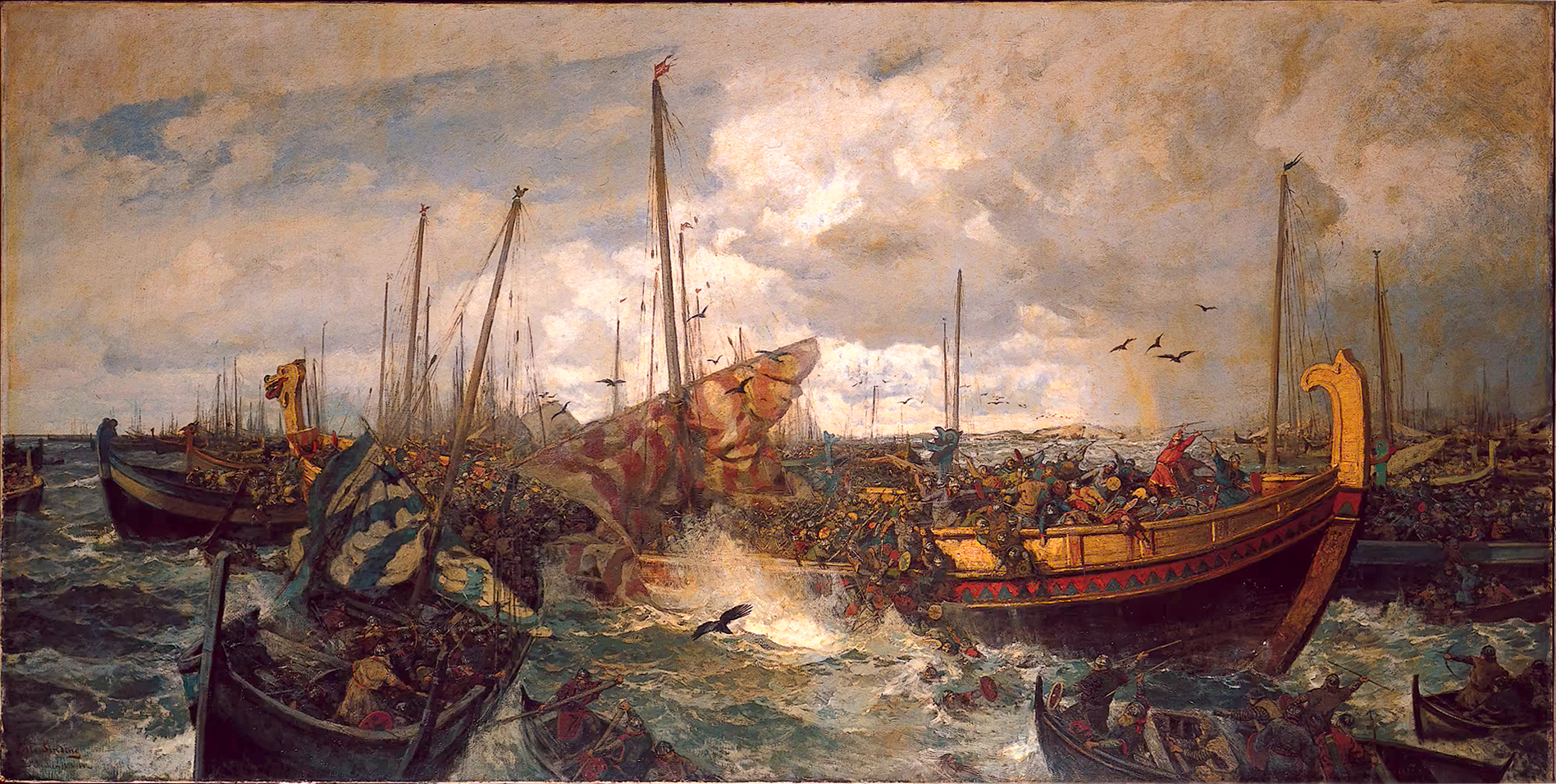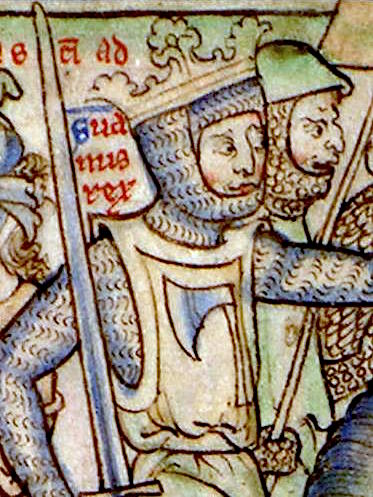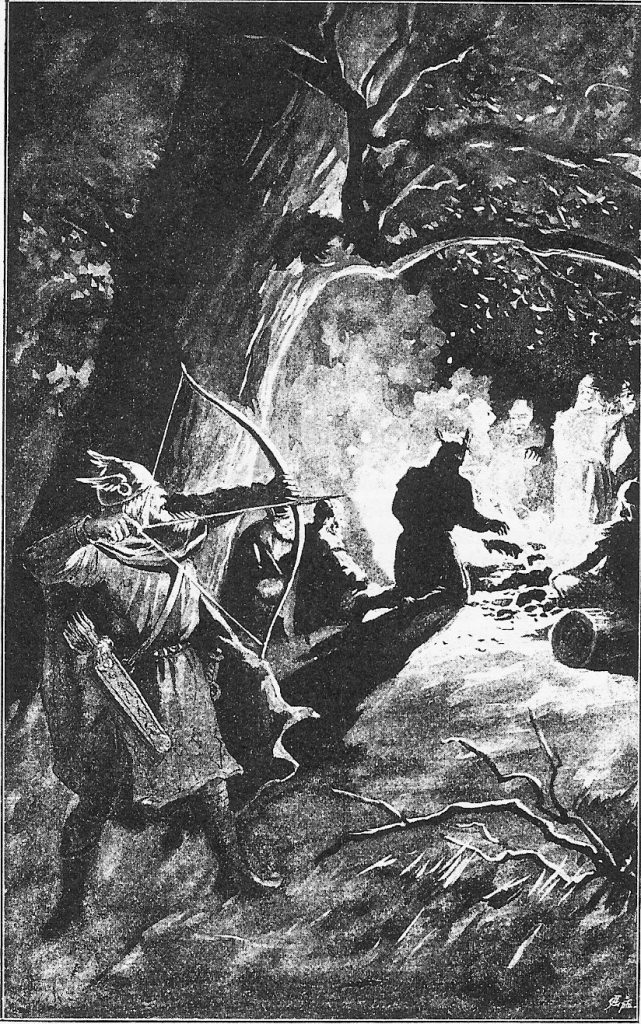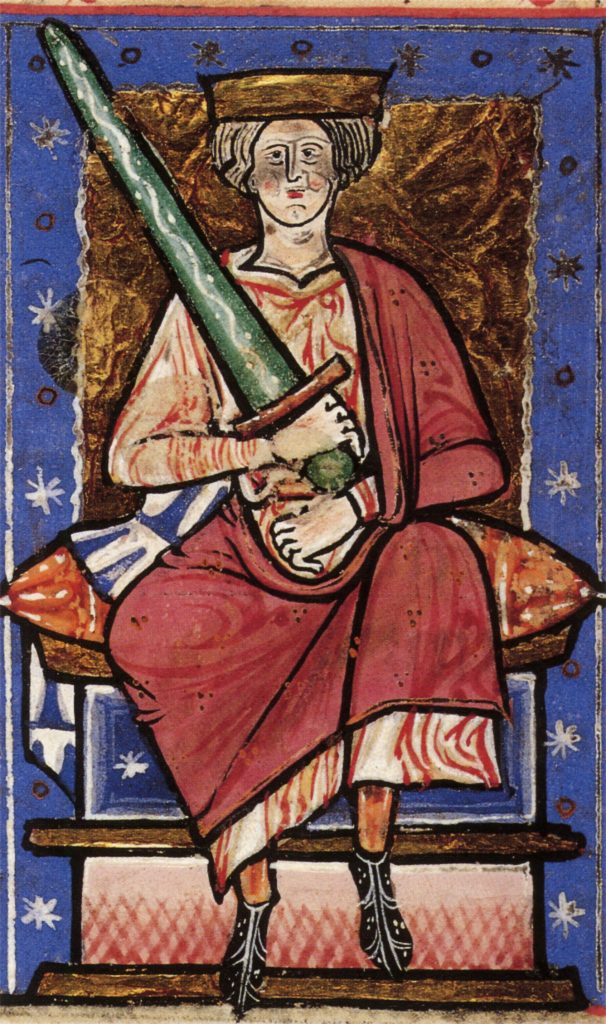
Jomsvikings at the Battle of Svolder, late 10th century
For more than a generation, the Danish House of Knytlinga (“Cnut’s Descendants”) held sway over much of southern Norway but the dream of creating a North Sea Empire by uniting the kingdoms of Denmark, Norway, and England did not become a reality until Sweyn Forkbeard (963-1014) – the ambitious son of King Harald Bluetooth – made an alliance with the Jomsvikings – a mercenary legion of warriors who lived on the southern shore of the Baltic coast. Legend has it the Jomsvikings – often called the Jomsborg Vikings – lived by a strict martial code that forbade capture in battle.

According to the Heimskringla – an Old Norse history of Norway’s kings written in the early thirteenth century – in 986 Sweyn seized the Danish throne from his father after the Jomsvikings “had come to his assistance…” Once he became king, Sweyn consummated the new partnership and “the Solemn Vow of the Jomsborg Vikings” with a feast where Sweyn laid out his larger plans to rule the kingdoms abutting the North Sea:
King Svein made a magnificent feast, to which he invited all the chiefs in his dominions; for he would give the succession-feast, or the heirship-ale, after his father Harald. […] The Jomsborg vikings came to the festival with their bravest men, forty ships of them from Vindland, and twenty ships from Scania. Great was the multitude of people assembled. The first day of the feast, before King Svein went up into his father’s high-seat, he drank the bowl to his father’s memory, and made the solemn vow, that before three winters were past he would go over with his army to England, and either kill King Adalrad (Ethelred), or chase him out of the country. This heirship bowl all who were at the feast drank. Thereafter for the chiefs of the Jomsborg vikings was filled and drunk the largest horn to be found, and of the strongest drink. When that bowl was emptied, all men drank Christ’s health…[1]
Saga of the Jomsvikings
Although some historians have disputed elements of the Jomsvikings legend, the thirteenth-century Icelandic Saga of the Jomsvikings sheds light on the alliance made between King Sweyn and the mercenary brotherhood. According to the saga, the order was founded by a man named Palnatoki, who sided with Sweyn during the patriarchal dispute.

That the saga gives an account of the foundation of the Jomsvikings during the period Sweyn ascended the throne suggests that the two events and their goals were linked: “Palnatoki now went to Britain, and took over the kingdom… In the summer of the following year, King Svein sent men to Palnatoki to invite him to inherit, but Palnatoki still could not go…” It is after the association between the new king and the order is established that the saga describes Palnatoki’s founding of the Jomsborg citadel somewhere on the southern shore of the Baltic Sea:
Some parts of the city stood out, and he had the harbor made so large that there were mounds of three hundred longships, …there were iron gates and locks inside the harbor, and on the stone arch a large castle was made… This city is called Jomsborg… After this Palnatoki settled in Jomsborg with the advice of wise men, so that their excellency would be as wide-ranging as possible, and their power would be as great as possible.
Part of that consul included rules for maintaining discipline. Jomsvikings were required to come to the mutual assistance of other members, did not allow men to have their wives “in the city”, and only accepted members between the ages of eighteen and fifty. The saga also notes the Jomsvikings “keep their laws well. They go to war in various lands every summer, and get a good fortune.”[2] In the Heimskringla, Sweyn’s victory in the year 1000 over Norway’s King Olaf Tryggvason at the large Battle of Svolder on the western Baltic was credited in part to Jomsviking assistance and the cunning trap laid by Sweyn and Jomsviking spy Earl Sigvalde – who entered into Olaf’s good graces and beguiled the Norwegian king by saying that “‘It never can be King Svein’s intention to venture with the Danish force alone, to give battle to thee with such a powerful army…’” Sigvalde told Olaf that if he had any suspicions “that evil is on foot, I will follow thee with my force (at that time it was considered a great matter to have Jomsborg vikings with an army), and I will give thee eleven well-manned ships.’ The king accepted this offer…” Thus, the trap was set, and Sweyn became king of Norway when Olaf threw himself into the sea to avoid being captured when he realized the battle was lost.[3]
1013 Invasion of England
Danish and other Scandinavian settlers had long been colonizing lands in northern England, but serious conflict began in 1002 after the English King Ethelred the Unready – who had been paying (Danegeld) tribute to the Danish king – ordered a massacre of Danish settlers near modern day Oxford in response to an increase in raids. One of the victims of the St. Brice’s Day massacre – as it was later called – may have been Sweyn’s sister Gunhilde – who was married to a Danish chieftain. In any event, after the massacre Sweyn began raiding the English coast and acquired massive amounts of tribute to fuel his army.

In 1009, Thorkell the Tall – a prominent Jomsviking lord – paved the way for Sweyn’s final conquest of England by invading Kent. According to the Anglo-Saxon Chronicle, in July of 1013, Sweyn led a full-scale invasion “about East-Anglia into the mouth of the Humber, and so upward along Trent,” and soon after “all the Northumbrians submitted to him…” After that Sweyn “went southward with all the forces, and committed the ships and the hostages to his son Canute. […] Then went he to Oxford, and the townsmen soon submitted, and delivered hostages… Then went he thence eastward to London…” Although Thorkell initially supported the English king against Sweyn, the invading army was so overwhelming Ethelred sent his sons into exile in Normandy and fled to the Isle of Wight. On Christmas day in 1013, Sweyn became the first Danish king of England and the first ruler of the North Sea Empire. Mysteriously, Sweyn died in early 1014 after achieving his dream, but with the help of his father’s allies, his son Cnut would reunite the realm.[4]
[1] Samuel Laing, The Heimskringla or the Sagas of the Norse Kings from the Icelandic of Snorre Sturlason, Vol. 2(New York: Scribner & Welford, 1889), 120-121. One of Sweyn’s wives was allegedly the daughter of Mieszko I of Poland, who spent much of his reign working to control the Baltic coast of Pomerania and Gdansk near the Oder River. This marriage complemented the military alliance made with the Jomsvikings, who lived on the western flank of Miesko’s realm.
[2] Jomsvikinga saga, Konungasögur, Íslenskar fornbókmenntir [Kings’ Stories, Icelandic ancient literature] (Reykjavik: National and University Library of Iceland, 1824), 10-15. There is evidence that the location of Jomsborg was on the island of Wollin, near the mouth of the Oder River.
[3] Samuel Laing, The Heimskringla or the Sagas of the Norse Kings from the Icelandic of Snorre Sturlason, Vol. 2, 210. See: Otto Sinding (1843-1909) painting, The Battle of Svolder.
[4] John A. Giles, The Anglo-Saxon Chronicle (London: G. Bell and Sons, 1914), 101-2. See: Grace Faulkner Ward, “Jomsburg Brethren in England.” Scandinavian Studies 28, no. 4 (1956): 135–41.
About the author
Benjamin J. Swenson has been living and working in Korea since 2008. His doctoral dissertation at Pompeu Fabra University (UPF) in Barcelona, Spain, covered Euro-American military and legal history, and the advent of guerrilla warfare and counterinsurgency doctrine in the nineteenth century. He is currently an Assistant Professor in the Department for Human Creativity at Hoseo University in Asan – where he lives with his wife and son. His hobbies include chess, painting, hiking, and bonsai.
One thought on “Sweyn Forkbeard: First Danish King of England and the Alliance that Forged the North Sea Empire, 986-1014AD (Part I)”